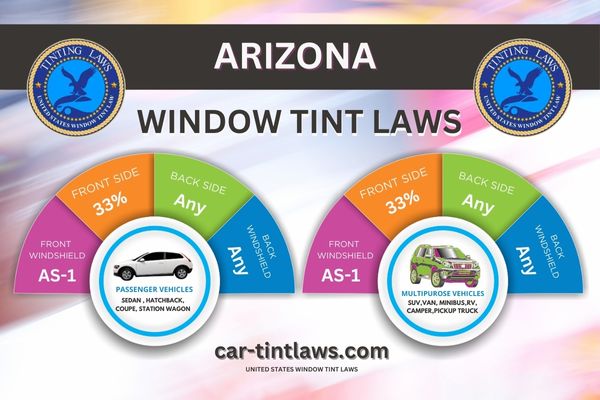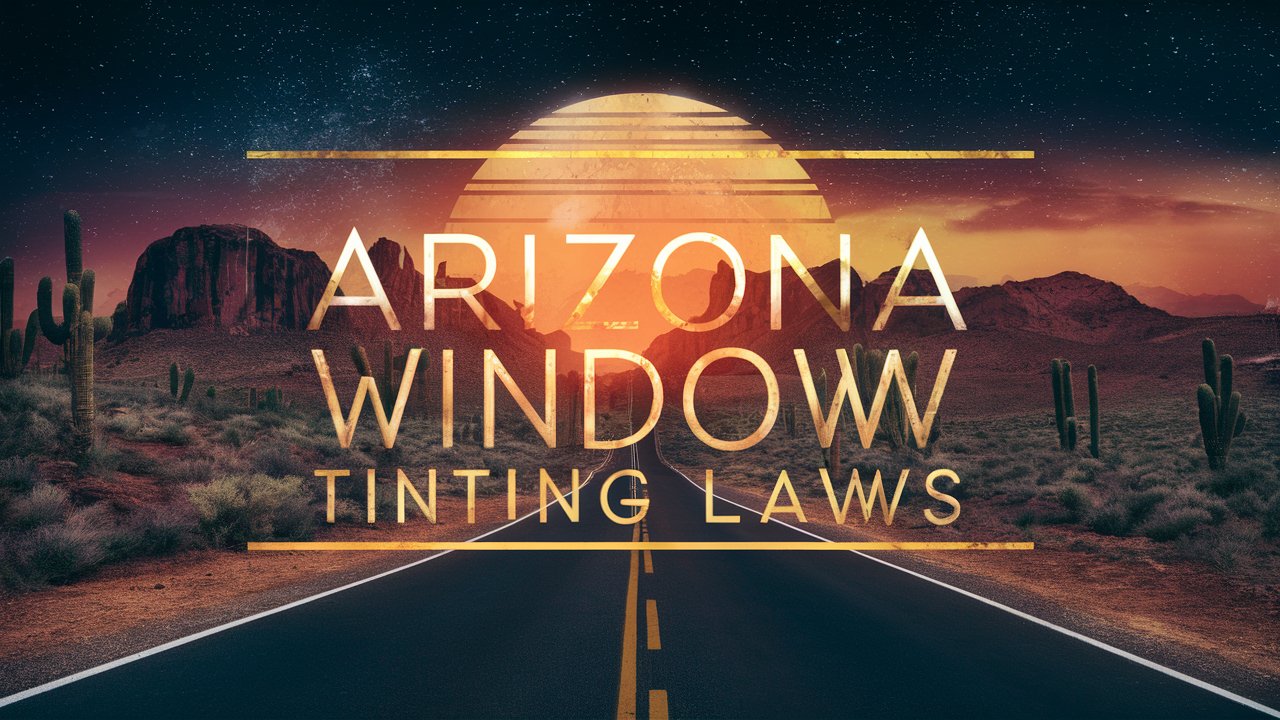When you’re considering tinting your vehicle’s windows in Arizona, it’s essential to understand the specific legal requirements to avoid hefty fines.
Arizona’s regulations vary based on the type of vehicle, with different rules for sedans, SUVs, and vans.
You might be interested to know that while reflective tint is allowed up to 35%, there are no restrictions on the color of the tint. Also, if you have a medical condition like glaucoma, you could qualify for an exemption.
Curious about how to ensure your tint complies and what steps to take for medical exemptions?
Let’s explore further.
Window Tint Darkness in Arizona
When considering window tint darkness in Arizona, you need to know the specific regulations for different types of vehicles.
For sedans, the front side windows must allow more than 33% of light to pass through, while the back and rear windows can be any darkness level, as long as they comply with state regulations.
SUVs and vans follow the same rules, so make sure your tinting doesn’t exceed the allowed reflectivity or darkness limits.
Tint darkness for sedans:
- Windshield: Non-reflective tint is allowed on the top 6 inches of the windshield.
- Front Side windows: Must allow more than 33% of light in.
- Back Side windows: Any darkness level is permitted.
- Rear Window: Any darkness level is permitted.
Tint darkness for SUV and Vans:
- Windshield: Non-reflective tint is allowed on the top 6 inches of the windshield.
- Front Side windows: Must allow more than 33% of light in.
- Back Side windows: Any shade can be used.
- Rear window: Any shade can be used.
Window Tint Reflection in Arizona
When considering window tint reflection in Arizona, you’ll need to know how it differs for various vehicle types.
For sedans, the maximum reflective tint allowed is 35% for both backside and rear windows.
SUVs and vans follow the same regulation, ensuring that the tint’s reflective properties enhance visibility and reduce heat without exceeding legal limits.
Tint reflection for sedans:
- Front Side windows: Must not exceed 35% reflectivity.
- Back Side windows: Must have a tint with 5-35% reflectivity.
- Rear Window: Must have a tint with 5-35% reflectivity.
- Windshield: Only non-reflective tint is permitted above the AS-1 line.
Tint reflection for SUV and vans:
- Front Side windows: Must not be more than 35% reflective.
- Back Side windows: Must not be more than 35% reflective.
- Back windows and Rear windows of SUVs and vans: Reflective tint can range from 5% to 35%.
- Maximum allowed luminous reflectiveness for all vehicles: 35%.
Other Arizona window tint rules and regulations
- Side Mirrors: No restrictions.
- Restricted Colors: In Arizona, all tint colors are permitted.
- Certificates: Manufacturers of film need to certify the film they sell in the state. Ensure your dealer is using certified film.
- Stickers: A sticker or label of compliance to identify legal tinting is required between the film and glass on each tinted window.
- Medical Exceptions: Arizona allows for medical exemptions for special tint. To learn more about the specific terms of the exemption, refer to Arizona state law.
- Penalties: Violating tint laws in Arizona without an exemption can result in fines. The cost of a window tint ticket may vary based on the officer’s discretion and the severity of the infraction.

Medical Exemptions for Window Tint Rules in Arizona
You can obtain a medical exemption for window tint rules in Arizona if you have conditions like glaucoma or skin cancer.
These medical exemptions allow you to bypass the standard tinting limits set by Arizona window tinting laws.
To qualify, you need a signed document from your doctor, which must be submitted to the Medical Review Program for evaluation.
This exemption is especially beneficial for those who require protection from sun exposure while driving.
Having a medical exemption means you can have a darker tint than typically allowed, providing additional driving protection for sensitive eyes or skin.
Conditions such as glaucoma and skin cancer can make you more susceptible to the sun’s harmful rays, and standard tinting limits may not offer adequate protection.
By obtaining a medical exemption, you can guarantee that your vehicle’s windows are tinted to a level that meets your specific health needs.
The process is simple: get a signed document from your doctor, submit it to the Medical Review Program, and wait for approval.
Once granted, your exemption allows you to legally have darker window tints, giving you the necessary protection while driving in sunny Arizona.
Arizona Department of Transportation – Window Tinting Exemption
Arizona Department of Transportation – Medical Review FAQ
Arizona Window Tint Ticket Cost
Violating Arizona’s window tint laws can result in a ticket costing up to $250 per violation.
If you’re caught operating a vehicle with non-compliant tint, you may receive a fix-it ticket, which typically gives you a chance to correct the issue and avoid further fines.
However, if the tint on your windows is excessively dark and doesn’t meet the state’s regulations, you could face citations that come with fines and penalties.
Arizona window tint ticket cost can quickly add up, especially if you have multiple violations.
It’s important to know that these fines aren’t just a one-time fee; each violation can carry its own cost, potentially hitting your wallet hard.
The state’s law enforcement is vigilant about enforcing these rules to guarantee safety on the roads.
In addition to fines, non-compliant tint can lead to penalties that affect your driving record.
If you’re repeatedly caught with illegal tint, the penalties can become more severe, leading to higher costs and more significant consequences.
Understanding and complying with Arizona’s window tint laws not only helps you avoid citations but also keeps you within legal operating standards.
Arizona State Overview
Arizona’s intense climate and high sun exposure make understanding window tinting laws vital for your comfort and safety.
The state has specific legal tint percentages for different windows, with front side windows needing to allow more than 33% light transmission, while back and rear windows can be any darkness.
Enforcement and penalties for non-compliance are strictly handled, so it’s crucial to make sure your vehicle meets all regulations.
Climate and Sun Exposure
How does the intense desert climate of Arizona, with its average of 300 sunny days per year, impact residents’ need for window tinting?
In Arizona, the high levels of sun exposure and UV radiation are significant concerns due to the state’s desert climate.
With so much sunlight, residents face an increased risk of skin damage and sunburn.
Window tinting becomes essential for protecting yourself and your loved ones from harmful UV rays, which can lead to serious skin conditions over time.
Additionally, the extreme heat in Arizona can cause interior damage to your vehicle, such as fading upholstery and cracking dashboards.
Tinted windows offer vehicle protection by reducing the amount of heat that enters, thereby preserving the interior and extending the lifespan of your car’s components.
Glare reduction is another key benefit of window tinting, preventing the blinding effects of the sun while driving and enhancing road safety.
Legal Tint Percentages
Given the intense sun exposure and need for protection in Arizona, it’s crucial to understand the state’s legal tint percentages to guarantee compliance and maximize benefits.
Arizona window tinting laws specify that front side windows must allow more than 33% of light to pass through, which means the Visible Light Transmission percentage (VLT) should be above 33%.
This helps secure that while you enjoy some UV ray skin protection, you also remain within legal bounds.
For your back and rear windows, Arizona State regulations are more lenient, allowing any level of darkness.
This flexibility can offer greater privacy and further protection from the sun’s rays.
However, keep in mind that the reflectivity of your Window Tinting Film must not exceed 35%, ensuring it complies with the state’s Bylaws on Window Tinting.
When it comes to your windshield, the tint must be non-reflective and only applied above the AS-1 line.
Staying within these guidelines helps you avoid Tinting Violations and Penalties.
Maintaining that your vehicle’s window tint adheres to these standards will keep you in line with Arizona’s legal window tint laws and provide you with the protection you need.
Enforcement and Penalties
Law enforcement in Arizona takes window tint regulations seriously, utilizing tint meters to guarantee compliance and issuing citations for violations.
If your vehicle’s windows are too dark, you risk getting pulled over.
Officers use a tint meter to measure the window darkness, verifying it complies with Arizona’s legal limits.
Violating tint laws can lead to fines of up to $250 per violation.
In addition to fines, you might receive a fix-it ticket, which requires you to correct the illegal tint within a specified timeframe.
If you don’t comply, further penalties could follow.
Operating a vehicle with non-compliant tint isn’t just about avoiding fines; it’s about staying on the right side of the law.
Non-compliance could result in multiple citations, adding up both financially and legally.
Enforcement efforts focus on maintaining road safety, so it’s essential to be aware of the legal limits for window tint and make sure your vehicle meets these standards.
References
Arizona Revised Statutes section 28-959.01: materials on windows or windshield
Frequently Asked Questions
What Is the Darkest Legal Tint in Arizona?
The darkest legal tint in Arizona allows any darkness for back and rear windows, but be mindful of 35% reflectivity.
Tint percentage affects UV protection, glare reduction, heat reduction, car aesthetics, and safety benefits, avoiding legal repercussions.
Is 20% Tint Legal in Arizona?
Yes, 20% tint is legal on back and rear windows in Arizona. This tint percentage helps with vehicle safety, heat reduction, privacy concerns, UV protection, and car aesthetics.
Guarantee proper installation and tint maintenance to avoid visibility issues.
Can You Get Pulled Over for Tint in Az?
Oh, you bet you can get pulled over for tint in AZ! Tint fines, tint tickets, and tint consequences are no joke.
Police discretion allows for tint inspections. Non-compliance with tint regulations might even require tint removal or repair.
How to Get Tint Exemption in Az?
To get a tint exemption in AZ, you’ll need documentary proof of medical reasons.
Start the tint exemption process through vehicle inspection and meeting legal requirements.
Restricted conditions and exemption renewal require administrative approval and compliance with visual light transmission standards.
Conclusion
Steering through Arizona’s window tinting laws is like maneuvering through a maze, demanding meticulous attention to detail.
You must know the precise tint darkness and reflection limits for your vehicle type.
Confirm your tint is certified, and affix compliance stickers on your windows. If you have a medical condition, seek an exemption.
Adhering to these regulations is essential to evade fines and guarantee road safety. Grasping these rules helps you drive lawfully and securely in Arizona.
